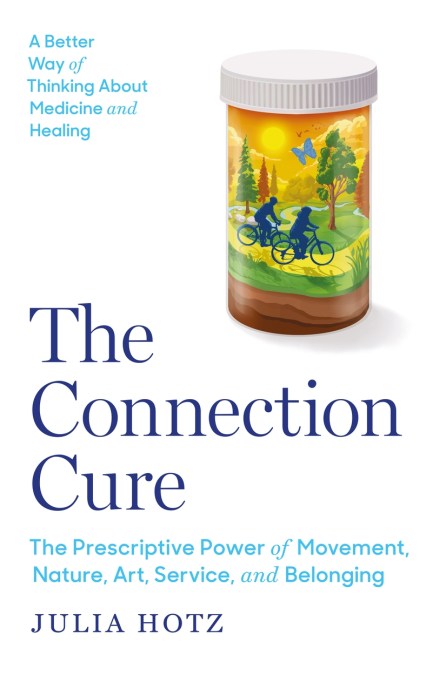‘A brave, fascinating, and persuasive read – and will soon become the definitive book on social prescribing. Full of integrity, humor, and great storytelling, this book will change lives, and possibly the world.’
Dr. Michael Dixon, OBE, author of Time to Heal and former NHS National Lead for Social Prescription
In this combination of diligent science reporting, moving patient success stories, and surprising self-discovery, journalist Julia Hotz helps us discover lasting and life-changing medicine in our own communities.
Traditionally, when we get sick, health care professionals ask, “What’s the matter with you?” But around the world, teams of doctors, nurses, therapists, and social workers have started to flip the script, asking “What matters to you?” Instead of solely pharmaceutical prescriptions, they offer ‘social prescriptions’-referrals to community activities and resources, like photography classes, gardening groups, and volunteering gigs.
The results speak for themselves. Science shows that social prescribing is effective for treating symptoms of the modern world’s most common ailments-depression, ADHD, addiction, trauma, anxiety, chronic pain, dementia, diabetes, and loneliness. As health care’s de facto cycle of “diagnose-treat-repeat” reaches a breaking point, social prescribing has also proven to reduce patient wait times, lower hospitalization rates, save money, and reverse health worker burnout. And as a general sense of unwellness plagues more of us, social prescriptions can help us feel healthier than we’ve felt in years.
As Hotz tours the globe to investigate the spread of social prescribing to over thirty countries, she meets people personifying its revolutionary potential: an aspiring novelist whose art workshop helps her cope with trauma symptoms and rediscover her joy; a policy researcher whose swimming course helps her taper off antidepressants and feel excited to wake up in the morning; an army vet whose phone conversations help him form his only true friendship; and dozens more. The success stories she finds bring a long-known theory to life: if we can change our environment, we can change our health. By reconnecting to what matters to us, we can all start to feel better.
Dr. Michael Dixon, OBE, author of Time to Heal and former NHS National Lead for Social Prescription
In this combination of diligent science reporting, moving patient success stories, and surprising self-discovery, journalist Julia Hotz helps us discover lasting and life-changing medicine in our own communities.
Traditionally, when we get sick, health care professionals ask, “What’s the matter with you?” But around the world, teams of doctors, nurses, therapists, and social workers have started to flip the script, asking “What matters to you?” Instead of solely pharmaceutical prescriptions, they offer ‘social prescriptions’-referrals to community activities and resources, like photography classes, gardening groups, and volunteering gigs.
The results speak for themselves. Science shows that social prescribing is effective for treating symptoms of the modern world’s most common ailments-depression, ADHD, addiction, trauma, anxiety, chronic pain, dementia, diabetes, and loneliness. As health care’s de facto cycle of “diagnose-treat-repeat” reaches a breaking point, social prescribing has also proven to reduce patient wait times, lower hospitalization rates, save money, and reverse health worker burnout. And as a general sense of unwellness plagues more of us, social prescriptions can help us feel healthier than we’ve felt in years.
As Hotz tours the globe to investigate the spread of social prescribing to over thirty countries, she meets people personifying its revolutionary potential: an aspiring novelist whose art workshop helps her cope with trauma symptoms and rediscover her joy; a policy researcher whose swimming course helps her taper off antidepressants and feel excited to wake up in the morning; an army vet whose phone conversations help him form his only true friendship; and dozens more. The success stories she finds bring a long-known theory to life: if we can change our environment, we can change our health. By reconnecting to what matters to us, we can all start to feel better.
Newsletter Signup
By clicking ‘Sign Up,’ I acknowledge that I have read and agree to Hachette Book Group’s Privacy Policy and Terms of Use

